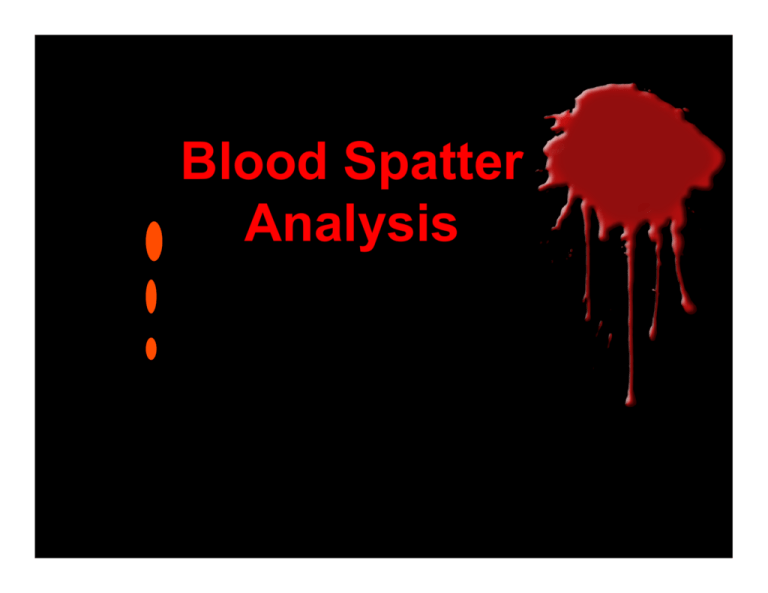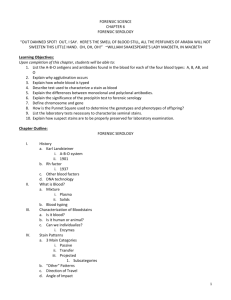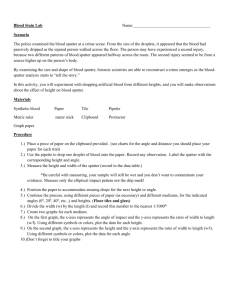Blood Spatter Analysis: Forensic Science Presentation
advertisement

Blood Spatter Analysis Blood Spatter (not splatter) is the pattern of blood created when blood is deposited on a surface. History of Blood-Spatter Analysis • 1894 – Pitoroski wrote the earliest reference on blood-spatter analysis • 1939 – Blathazard was the first researcher to analyze the meaning of the spatter pattern • 1955 – blood-spatter evidence was used by the defense in the Sam Shepard case, eventually exonerating him • 1971 Dr. Herbert MacDonnell used blood-spatter analysis as a tool in modern forensic examinations. Blood Detection • Phenolphthalein • Luminol Blood spatter “tells a story” • Where was person located when bleeding? • What direction was blood traveling? • What was the angle of impact? What was the distance between bleeder and the striking surface? • How many events occurred? Blood Spatter • Used to explain events at a violent crime scene – Direction blood travels – Angle of impact – Blood velocity (manner of death) – Point of origin Physical Properties • Cohesion - blood sticks together as it falls • Gravity - pulls blood downward • Surface tension - blood drops that fall on a flat surface have a curved surface • Edges may have spikes or extensions • Satellites - small secondary droplets 6 patterns of blood spatter 1. Passive fall (90o angle to floor)– circular drops w/secondary satellites 2. Arterial spurts or gushes 3. Splashes – show position of victim 4. Smears – bleeding victim touching walls or furniture 5. Blood Trails – victim moving from one place to another 6. Blood Pools – victim bleeds heavily splash arterial spurts passive fall blood pool multiple drips smear • Cast off pattern: blood from a moving object coated in blood (pipe, knife) • Fine-mist spatter: high-velocity impact (gunshot) • Void: empty space; victim/ attacker/object moved after attack Blood Spatter Types 1. High velocity – gunshot wounds 2. Medium velocity – beating, stabbing 3. Low velocity – blunt object impact Lines of Convergence • Location of the source of blood can be determined if there are at least two drops of blood spatter • Determine source of blood (point of origin) • Draw straight lines down long axis of blood spatter where lines intersect will indicate the lines of convergence Crime-Scene Investigation of Blood 1. Confirm the stain is blood. Ø Visualization with Luminol Ø Kastle-Meyer test – if present a dark pink color is produced Ø Leukomalachite green – produces green color in the presence of blood 2. Confirm the stain is human. Ø ELISA test – Enzyme Linked Immunosorbent Assay 3. Determine blood type. Ø Antibody test Simpson Crime Scene Is blood spatter evidence consistent with the story told by witness or suspect? Characteristics of a single drop of blood Spike vs. satellite Surface variations Smooth (glass) Slightly raised floor tiling varnished wood, fabric Rough tile unvarnished wood Blood dropped from different heights Transferred blood Footprint Handprint Patterns of transfer ceiling Cast-off from Weapon Direction of travel of blood Wave Cast-off Tail of elongated stain points in direction of travel . Tail of wave cast-off points back to parent drop Parent drop wave cast-off 5 ml blood squirted from a syringe from height of 1 m Point of Convergence Point of Convergence Lines of Convergence • Draw line through the axis of the main droplet • Start at the end of the blood drop and draw toward the source • Do not draw lines through satellite drops • Draw smallest circle around intersection marks point of convergence Lines of Convergence Determine Point of Convergence Don’t over extend the lines! Draw towards the source of blood Let’s practice! Answer Sheet for Lines of Convergence Height above point of convergence Angle of Impact Origin length width Angle of impact = arc sin W/L 85° 60° 45° Distance from point of convergence 30° Determine Angle of Impact Width Length sine arc sine 42° 2 3 .6667 1 4 .25 14.5° 9.6 9.7 .9897 82.2° Angle of Impact W Path of blood 90° 60° 80° 50° a 70° 40° l l Floor 30° 20° 10° Practice Paper Blood Droplets • Draw lines of convergence • Determine point of convergence • Measure blood drop width/length • Determine impact angle Can you determine point of origin? Tracing Origin of Bloodspots • Point of convergence – 2 dimensional image • Point of origin – adds 3rd dimension to image • In practice: – use of string & protractor at scene – use of computer at laboratory Calculate Point of Origin • Draw lines of convergence • Determine point of convergence • Determine impact angle • Use protractor to determine origin Or Use Law of Tangents Law of Tangents (TOA) Tangent of Angle = Opposite Adjacent mm mm H E I X G Y H T XJ Distance Thanks for coming










